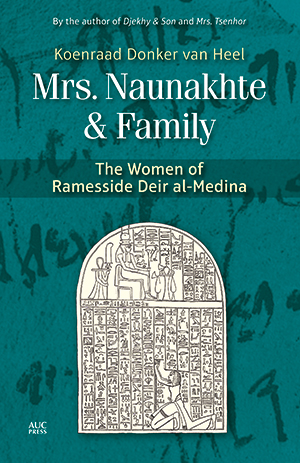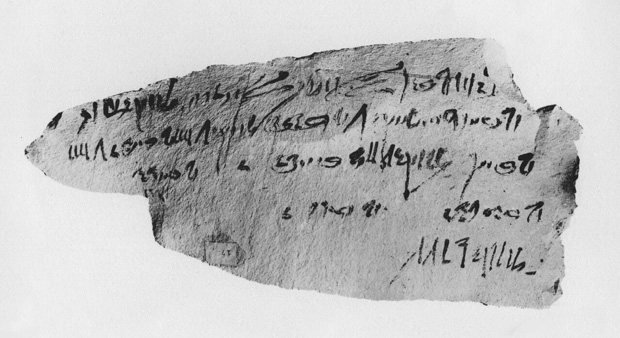AUC Press 2016
264 pp.
Hardbound
$34.95
ISBN 9789774167737
Stand-up Egyptologist Koenraad Donker van Heel is at it again with a third popular book about business-minded ancient Egyptians. This time he chooses to resurrect a woman called Naunakhte who lived in the artist community of Deir el-Medina around 1150 BCE. Her village was home to the craftsmen who decorated the splendid sepulchres in the Valley of the Kings, and in their spare time, their own delightfully snug and colourful tombs in the nearby hill-side. Mrs. Naunakhte has an interesting past and quirky family. In year 3 of Ramesses V she appeared in court to state her testament: three of her eight children were to be disinherited because they had failed to look after her.
Donker van Heel, papyrologist and copywriter in the daytime, sets out to reconstruct Naunakhte’s life down to her ‘kitchen-table conversations’. The intended audience is a modest ‘everyone’, although DvH likes to hurl around complex ostraca numbers and obscure (to most people) Egyptologists. In general, the book is a lovely whirlwind of more or less related subjects interspersed with witty commentary. Although Mrs. Naunakhte herself is sometimes conspicuously absent (for lack of sources, not for lack of trying), the reader is entertained with everything from marriage and the position of women in ancient Egypt to court cases, tomb robbery, an eccentric scribe with bad handwriting and donkeys without licence plates.
The problem with Deir el-Medina is that our knowledge of the place is at once incredibly detailed and, on a basic level, lacking greatly. We have heaps of shopping lists, receipts, rosters and passive aggressive notes to know who slept with whose wife, who was drunk and absent from work, who received what amount of grain on which day, and (yes) who peed on the royal tomb (Paneb, always Paneb). But we have no idea if there was female literacy, whether it was OK for the state employees to have a job on the side, or why the workmen had such a large amount of free time. Thus we know that Naunakhte married the senior scribe Qenhirkhopshef (the one with the bad handwriting), but not exactly at what age (twelve has been suggested – he was 52). She inherited his personal library, but could she read and write? We know that her four surviving sons from her second marriage did. Perhaps she even taught them?
During the 8-day work week, the men of Deir el-Medina were mostly off to the Valley to hack away at tombs accompanied by sparse oil-lighting. They slept in huts up in the mountain. During the weekends (day 9-10) they returned to the village and its cramped but comfortable houses. The fact that we know so much about this small and exceptional community is due to the thousands of documentary ostraca (limestone flakes or pottery shards) and papyri recovered from a nearby pit. Throughout the book, DvH quotes excessively from these sources, showing that often, more questions are raised than answered.
The written messages are expressive and often humorous. In O. (ostracon) DeM 303 a draftsman complains to Naunakhte’s first husband about a distressing lack of beer:
‘(…) For you I am like a donkey. If there is work to do, bring the donkey. If there is food, bring the ox. If there is beer, you do not look for me, but if there is work to do, you look for me (…). PS: I am a man without beer in his house. (…)’ (p. 45)
Rather than beer, DvH is in search of the women of Deir el-Medina. We find women appearing in the local court as both accused and court members (p. 49). Expensive copper chisels were among the things most heartily stolen. Women could file complaints against others as well, although being of good social standing might have been a prerequisite (p. 74). Women could have jobs on the side, just like their men did (p. 77). Also, they could own nearby fields and offer these up as payment (p. 79), or question the proper disbursement of their parents’ inheritance (p. 85). Beside the local (qenbet) court, clear questions (‘Did Ramesses steal my bike?’) could be put forward to an oracle (in practice a statue carried by eight priests) that worked in mysterious ways to answer with a decisive ‘yes’ or ‘no’. There were even ‘female freelancers’ (p. 197) working in the household, and perhaps as weavers, greengrocers and wet nurses. And, as we see in the will of Naunakhte, a woman could divide her inheritance according to her wish.
Thus it was on a fine day in year 3 of Ramesses V that the distinguished Mrs. Naunakhte appeared before court and declared which of her children were to gain from her property. Having no children from her first marriage to the scribe Qenhirkhopshef (which would have complicated matters), her eight surviving children from her second husband Khaemnun were to profit from her will. But not before Naunakhte scratches off two daughters and one son from the list. The daughters for not looking after her in her old age, the son for being a penniless bum. As a consequence, these children would not share in the estate of her first husband, although they would receive from the joint property she acquired with their father Khaemnun:
‘As far as I am concerned, I am a freewoman of the land of Pharaoh, life, prosperity, health. I have raised these eight servants of yours. I gave them a household outfit of all things that is usually done for the likes of them. Now see, I have grown old, and see, they are not taking care of me in turn. As for anyone among them who laid his hand on my hand (cared for me), I will give him my things. As to the one who has not given me, I will not give him from my things.’
Part of the inheritance was a storeroom, but also such items as a bronze washbowl, sacks of emmer corn and a quantity of fat. The penniless bum could keep the items he had already borrowed from his mum (a kettle, chisel, vase and adze totalling 40 deben) and consider that his share. Likely, Naunakhte’s statement caused dissent within the family (judging by some further court cases), while at the same time serving as a reality soap opera to the other villagers.
DvH manages to resurrect the tiny mudbrick houses of Deir el-Medina and fills them with the laughter and quarrels of many a colourful character. It is incredible to think that we know such intimate details about people who lived 3000 years ago. In between hysterical chapter titles (‘Was Neferhotep a Wimp?’) and witty commentary (‘in the otherwise turbulent year 29 of Ramesses III, [Menatnakhte] apparently also found time to have sex with the workman Weserhat’, p. 119), the author paints an elaborate picture of ancient life in all its petty bourgeois glory. He seems to have a school boyish interest in sex (‘where there are people there will be sex in one way or another’, p. 169) and excreta (‘Pandora’s Enema’, p. 190), up until the etymology of the Dutch word ‘neuk’. DvH succeeds in his aim to bring the Egyptians closer to us. In his own words: ‘These people worked, loved, hated, and died just like we do. They could be vulgar.’ (p. 188) Which reminds me that I should write an article about profanity in ancient Egypt.
One of the interesting topics touched upon is female literacy. Although there is no indisputable evidence that there were women in ancient Egypt who could read and write, it seems almost impossible that there weren’t. When I was little, I asked my brother how to read, and he explained it to me successfully in one sentence. When I taught hieroglyphs to a class of bright children aged 12-14, within 45 minutes they were able to read an Egyptian sentence. If Naunakhte inherited her husband’s library, is it unlikely to think that he taught her to read as well?
The author also poses some clever ideas. To turn the famous Who’s who at Deir el-Medina into an online extendable database (p. 105). To practice handwriting identification to figure out who wrote what (p. 116 – Many people in Deir el-Medina went by the same name. Perhaps OCR could even be useful in this?) To make the vast collection of Turin papyri available online (p. 168). That there should be a rule to publish material within five rather than 30 years, or forfeit the right of publication (p. 183).
All in all, Mrs. Naunakhte is a delightful affair that skips from one subject to another in a matter of paragraphs. Undoubtedly, more popular works are to be expected from this author. The only thing missing in my view are footnotes and a proper bibliography, but that may reflect an editorial choice (and my predilection for footnotes and bibliographies). I only wish more was known about Naunakhte herself – whether she regretted her life choices, what she thought of her husbands (we know what she thought of her children), and how she spent her days. But who knows what gems of documentary evidence are still stored away on dusty shelves of barred institutes, or lying at the bottom of a sandy pit.

Very interesting article about Deir el-Medina.
I thought that your review was lively and encouraging, Nicky. The only thing missing was the publication details of the book so that readers could buy a copy. Do include such details next time. V.G. Callender
Thank you! I put the link in twice 🙂